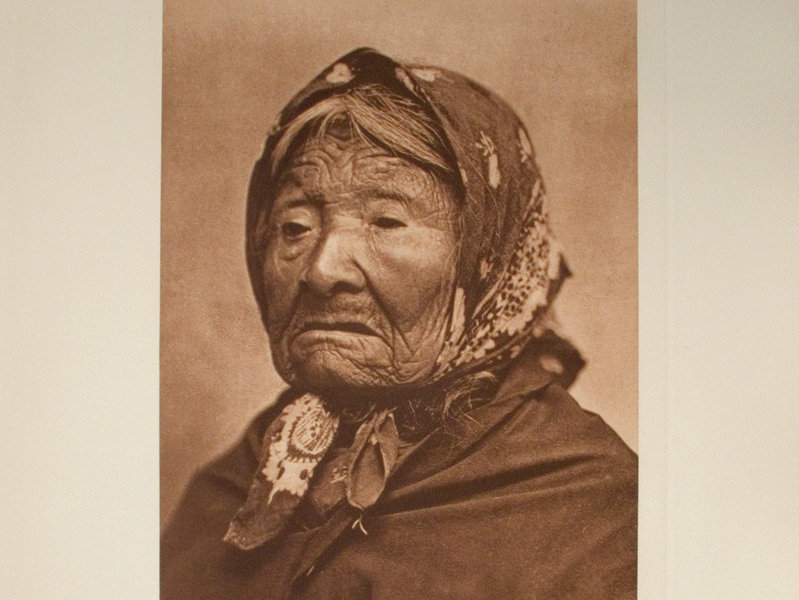Walking into "Edward S. Curtis and the Vanishing Race," a photography exhibition now on view at the Museum of Wisconsin Art in West Bend, I ask Director of Collections & Exhibitions Graeme Reid for the nugget on the Whitewater-born photographer and what he hands me is golden.
"The North American Indian, which was essentially (Curtis’) life’s work, is in my opinion and the opinion of others, probably the most significant achievement in American publishing history," Reid says, with no hint of doubt.
"(After) 25-30 years, depending on when you want to nail down his starting date, he finished it in 1930, all 20 volumes. At a time when America was in depression and nobody was really interested in buying $5,000 sets of books on people that quite frankly, most people really didn’t care about."
Talk about intrigue.
How does a photographer from Whitewater, with a sixth grade education come to create what museum curators nearly a century later celebrate as THE landmark in a publishing tradition that can boast the works of Hemingway and others?
Born in Whitewater in 1868, Curtis moves with his family to Minnesota and, by the late 1880s, is in the newly burgeoning Seattle, with his father, a wounded Civil War veteran. When his father gives him a lens, Curtis builds his own camera and begins exploring the new art and science of capturing images.
In Seattle, he buys into a portrait studio and stumbles into what will become the mission of his life when he convinces Princess Angeline, the last daughter of the late Chief Seattle, to sit for a portrait in 1899.
"This is one of the real key images," says Reid. "Here she is indigenous royalty and she’s living in a shack, digging for clams, an object of contempt and ridicule among the white community.
"She’s a kind of striking subject for a portrait, but I think Curtis thought, ‘there’s something wrong. We’ve named the town after her father, she’s treated like dirt and there’s something wrong with that.’ So he talked to her and cajoled her and had to pay her a dollar to get her into the studio."
In just a few years, Curtis abandons his studio to focus his energies on capturing the rapidly disappearing indigenous cultures, not only on photographic plates, but on dozens and dozens of Edison wax cylinders and in the copious notes he makes on cultural traditions, biographies and other related information.
"He started to realize that with every elder’s death, there went a whole lifetime of knowledge and experience," says Reid. "Because it is an oral tradition, he knew that when she dies, that history just goes."
There are 44 images in the show – and one image that is shown separately, among works from the museum’s permanent collection – which runs through Jan. 5, 2014. All are on loan from the Dubuque Museum of Art in Iowa. Images are grouped together thematically, showing cultural activities, family portraits, etc.
While some images, such as an image of two people and a boat on the beach, are stunningly beautiful and artistically composed, others have a more documentary feel.
Sometimes Curtis’ attempts to turn back the clock backfired on him as he tinkered with the signs of Western infiltration into native cultures. When he hamfistedly erased an alarm clock in a portrait of two men, critics pounced and claimed that he was tinkering with the truth.
But the truth was a bit more complicated than that.
"His own goal of the project," says Reid, "(was) to kind of present this as it was in the old days. ‘As it was in the old days’ kind of underpins the whole project. This is how it was and this is what has been lost."
"One of the reasons we put in the photo of Henry," says Reid, pointing to a portrait of a man hanging next to Curtis’ Princess Angeline, is to show that Curtis didn’t always attempt to re-write history.
"Curtis had an almost purity of vision. ‘I want it to match how I think it should look.’ So, we put that one in because here he is taking a portrait of somebody clearly wearing Western glasses. So, it’s not like he just took everything out."
What’s striking about the images is the richness of the subject matter. The variety and depth of the cultures that flourished in North America. Curtis focused his energies west of the Mississippi, says Reid, because by the time he begins his project, very few traditional cultures remained untouched to the east.
"In the ‘20s when he finally gets up to the Alaskan tribes, he’s like, ‘Oh my God, the missionaries haven’t gotten here yet.’ He was having to go to extremes to find unsullied communities. And he was willing to do it."
Reid says that many Native Americans treasure Curtis’ work because of the artist’s sensitivity to his subjects.
"To the best of my knowledge, there is not a single picture of Curtis donning any kind of headdress. He was kind of like, ‘no, I have too much respect. That is really not acceptable to do that.’ As the project went on he had more and more respect for the fact that it was literally just disappearing before his eyes."
And that’s another reason that Native Americans appreciate Curtis’ work: preservation.
"Native Americans in some ways really embrace what Curtis had done because, it’s like, ‘if he hadn’t of done this, I wouldn’t know what my native language sounded like.’"
Born in Brooklyn, N.Y., where he lived until he was 17, Bobby received his BA-Mass Communications from UWM in 1989 and has lived in Walker's Point, Bay View, Enderis Park, South Milwaukee and on the East Side.
He has published three non-fiction books in Italy – including one about an event in Milwaukee history, which was published in the U.S. in autumn 2010. Four more books, all about Milwaukee, have been published by The History Press.
With his most recent band, The Yell Leaders, Bobby released four LPs and had a songs featured in episodes of TV's "Party of Five" and "Dawson's Creek," and films in Japan, South America and the U.S. The Yell Leaders were named the best unsigned band in their region by VH-1 as part of its Rock Across America 1998 Tour. Most recently, the band contributed tracks to a UK vinyl/CD tribute to the Redskins and collaborated on a track with Italian novelist Enrico Remmert.
He's produced three installments of the "OMCD" series of local music compilations for OnMilwaukee.com and in 2007 produced a CD of Italian music and poetry.
In 2005, he was awarded the City of Asti's (Italy) Journalism Prize for his work focusing on that area. He has also won awards from the Milwaukee Press Club.
He has be heard on 88Nine Radio Milwaukee talking about his "Urban Spelunking" series of stories, in that station's most popular podcast.







